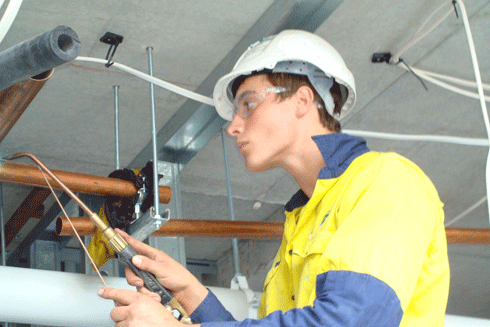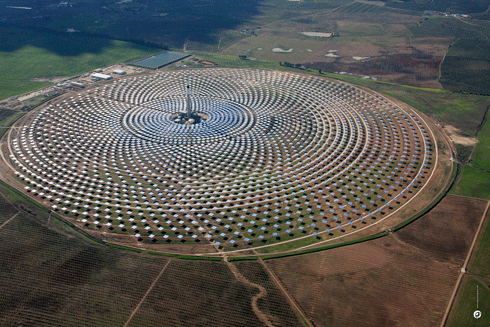
|
Published:
Skilling up for a low-carbon future: vocational education and training
Given the need for both short and long-term training for sustainability discussed in the first of this three-part series (ECOS 158, pp 22–24), it is clear that the vocational education and training sector will play a major role in building capacity for our nation over the next five years.
The Australian government’s second national action plan for education for sustainability,1 published in 2009, outlines ambitious strategies and actions for creating a sustainable future. Elsewhere, federal government departments have been working intensively on building capacity in energy efficiency knowledge and skills to deliver the national energy policy framework.2,3
In fact, the vocational education and training (VET) sector is already demonstrating leadership in curriculum renewal. Compared with universities, the VET sector’s curriculum is heavily regulated. This turns out to be a major advantage for rapid curriculum renewal, as policy can quickly translate to action in the classroom.
Several national and state policies and programs around the country are driving the VET sector’s momentum. These include the Australian government’s 2009 Clean Sustainable Skills Package,4 a $94 million investment in green jobs and training opportunities; and the 2009 Skills for the Carbon Challenge5 initiative, which provides national leadership for industry to develop and prosper in a sustainable, low-carbon economy.
The 2009 Green Skills Agreement6 commits all state and territory governments to working with trainers and businesses to ensure that relevant skills for sustainability are part of all VET curricula. In 2009, the Ministerial Council for Vocational and Technical Education endorsed a National VET Sector Sustainability Action Plan7, which provides a national framework to support curriculum renewal within the context of these national agreements.
With such comprehensive regulatory support for education for sustainability, how is the VET sector responding to the challenge? By far the most progress has been around the topic of energy efficiency. With support from the National Framework for Energy Efficiency (NFEE)’s National Strategy on Energy Efficiency8 and state energy efficiency industry groups, training materials are already being developed through collaborations between universities, state and federal agencies.
According to Ms Val MacGregor, from NFEE’s Training and Accreditation committee, what has been missing is practical guidance on how the required knowledge and skills can be developed.
‘At NFEE, we have been bridging this gap,’ says Ms MacGregor. ‘Last year, we commissioned research into the functional skills needed to undertake rigorous energy efficiency assessments, which have subsequently informed a summary list9 for VET training providers. Curriculum developers and trainers can use this immediately, which reduces their cost of developing materials and also creates a common language for training across the country.’
The importance of collaboration is also evident in early examples of energy efficiency training in Victoria, NSW and Queensland. In Victoria, Swinburne University – through the National Centre for Sustainability – has developed a Vocational Graduate Certificate in Energy Efficiency for Facility Managers and a Vocational Graduate Certificate in Building Energy Analysis (non-residential).10 The centre developed these courses in partnership with industry groups and NFEE. The centre has also developed a Diploma in Carbon Management, Australia's first accredited course in Carbon Accounting; a Diploma and Graduate Certificate in Sustainability; and, most recently, a Vocational Graduate Certificate in Education and Training for Sustainability.
In NSW, the Australian Research Institute on Education for Sustainability at Macquarie University is developing a teaching unit on Energy Efficiency and Renewable Energy,11 for inserting at the diploma or graduate diploma level in higher education or vocational education and training. This resource has been funded by the Department of Education, Employment and Workplace Relations, as part of its Skills for the Carbon Challenge initiative, and will be trialled within state VET institutes teaching energy efficiency.
In Queensland, the Department of Education and Training (DET) has several programs under way in collaboration with SkillsTech Australia, including the vocational graduate certificate (VGC) in Managing Sustainability Projects. Energy Skills Queensland (one of the Centres of Excellence established by DET) also established the Queensland Energy Efficiency Industry Leaders Group in 2009, which subsequently developed an ambitious Industry Action Plan for building capacity. The group has also helped to facilitate the development of energy efficiency assessment units within SkillsTech’s VGC program. Written in collaboration with The Natural Edge Project, the units help professionals access content previously developed under the ‘Energy Transformed: Sustainable Energy Solutions for Climate Change Mitigation’ education program.12
As Mr Des Harms from Queensland’s Department of Education and Training points out: ‘With so much happening in each state, we have a significant opportunity to benefit from sharing resources, to quickly build the capacity that has been targeted by the federal government’.
The VET sector’s progress also provides several lessons to universities considering curriculum renewal for education for sustainability. First, even with a topic such as energy efficiency, one training package will not satisfy all requirements. Rather, a suite of capacity building materials should be developed to provide a systematic response to different national and state issues.
Second, in addition to technical training, capacity building should incorporate a sense of what it means to be a change agent, and how to identify and overcome common barriers to effectively deliver sustainable solutions.
Finally, curriculum designers need to have an appreciation of which skill sets are being targeted, from ‘active’ (eg allowing for detailed knowledge of electrical and air conditioning systems), to ‘passive’ (eg understanding how to manage processes such as energy efficiency assessments, rather than knowledge of the actual systems).
The authors are from The Natural Edge Project, an Australian sustainability think tank, hosted by several universities in Australia. This is the second of three articles exploring the capacity building challenges facing the Australian tertiary education sector.
1 Department of Sustainability, Environment, Water, Heritage and the Arts (2009) Living Sustainably, The Australian Government’s National Action Plan for Education for Sustainability, Canberra.
2 Ministerial Council on Energy – National Framework for Energy Efficiency, http://www.ret.gov.au/Documents/mce/energy-eff/nfee/committees/consumer/focus.html
3 www.climatechange.gov.au/en/government/submissions/pm-task-group.aspx
4 http://tiny.cc/phk50
5 http://tiny.cc/qqns4
6 http://tiny.cc/0muyy
7 http://tiny.cc/ewf5j
8 www.coag.gov.au/coag_meeting_outcomes/2009-07-02/docs/Energy_efficiency_measures_table.pdf
9 www.ret.gov.au/energy/Documents/eex/FunctionalSkills_final.pdf
10 http://www.swinburne.edu.au/ncs/Education/education.html
11 www.aries.mq.edu.au/projects/deewr_energy_efficiency/
12 www.naturaledgeproject.net/Sustainable_Energy_Solutions_Portfolio.aspx




